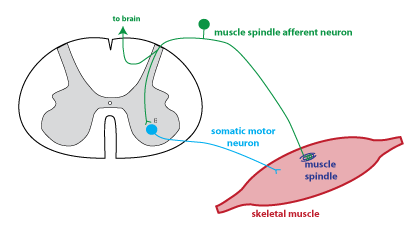
Greater musculotendinous tension enhances mechanical transduction to the muscle spindle, effectively improving mechanical coupling of the spindle and the stretch stimulus. Consequently, Rack et al 14 suggested that sufficient MTS must be present to compensate for this slack, allowing the muscle spindle to “see” an imposed mechanical load, and that greater compliance (inverse of stiffness) delays spindle excitation.
Stretch reflex series#
The musculotendinous unit possesses inherent series elastic slack. These neurons project monosynaptically onto homonymous α-motor neurons, thus producing a vigorous contraction, which resists the imposed lengthening. The SSR is elicited by a rapid increase in musculotendinous length, exciting Ia afferent neurons housed within the muscle spindle. Consequently, differences in musculotendinous stiffness did not appear to influence dynamic joint stability with respect to reflexive neuromuscular control. It appears unlikely that differences in musculotendinous stiffness influenced spinal stretch reflex sensitivity when initiated from a moderate level of pretension.

653) was related significantly to musculotendinous stiffness.Ĭonclusions: A moderate level of pretension (eg, 30%) likely eliminates series elastic slack thus, a greater change in force per unit-of-length change (ie, heightened stiffness) would have minimal effects on coupling of the muscle spindle and the stretch stimulus and, therefore, on spinal stretch reflex sensitivity. However, reflex latency (high stiffness = 50.11 ± 2.07 milliseconds, low stiffness = 48.26 ± 2.40 milliseconds) and amplitude (high stiffness = 0.28% ± 0.12% maximum motor response, low stiffness = 0.31% ± 0.16% maximum motor response) did not differ significantly across stiffness groups. Results: The high-stiffness group demonstrated significantly greater stiffness (137.41 ± 26.99 N/cm) than the low-stiffness group did (91.06 ± 20.10 N/cm). Main Outcome Measure(s): Triceps surae musculotendinous stiffness and soleus spinal stretch reflex latency and amplitude were assessed at 30% of a maximal voluntary isometric plantar-flexion contraction.

We also evaluated relationships between musculotendinous stiffness and spinal stretch reflex latency and amplitude, respectively. Intervention(s): We verified a sex difference in musculotendinous stiffness and compared spinal stretch reflex latency and amplitude in high-stiffness (men) and low-stiffness (women) groups. Patients or Other Participants: Forty physically active individuals (20 men, 20 women). Objective: To compare spinal stretch reflex latency and amplitude across groups that differed in musculotendinous stiffness. This heightened sensitivity would correspond with a shorter latency and higher-amplitude reflex response, potentially enhancing joint stability. Context: Greater musculotendinous stiffness may enhance spinal stretch reflex sensitivity by improving mechanical coupling of the muscle spindle and the stretch stimulus.


 0 kommentar(er)
0 kommentar(er)
